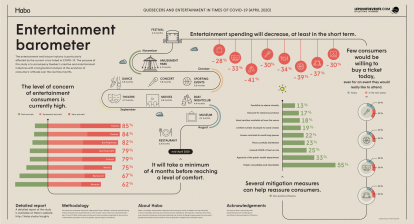January 16, 2018 – As the demographics of the Canadian population change, arts organizations find themselves challenged in retaining current audiences while attracting new ones. The question of attendance of the performing arts by Millennials, in particular, has been receiving some attention as of late. Here’s the first of two articles on the topic.
A diverse generation
 Depending on definitions and research studies, Millennials were approximately born between 1980 and 1995. But Millennials cannot be lumped into a single group defined by their age, as highlighted in a 2017 Environics Institute study. The Millennial generation is nearly as large as the Baby Boomers, but they manifest a much wider array of social values (world views and approaches to life) and they span more life stages: some are in school and living with parents, while others are starting families and careers. They are also the most diverse age cohort in Canada, consisting of 42.5 percent first or second generation immigrants to Canada (based on 2016 Census, 25-34 years old) and professing the nation’s most accepting attitudes regarding diversity of all kinds.
Depending on definitions and research studies, Millennials were approximately born between 1980 and 1995. But Millennials cannot be lumped into a single group defined by their age, as highlighted in a 2017 Environics Institute study. The Millennial generation is nearly as large as the Baby Boomers, but they manifest a much wider array of social values (world views and approaches to life) and they span more life stages: some are in school and living with parents, while others are starting families and careers. They are also the most diverse age cohort in Canada, consisting of 42.5 percent first or second generation immigrants to Canada (based on 2016 Census, 25-34 years old) and professing the nation’s most accepting attitudes regarding diversity of all kinds.
The millennial generation is highlighted on this 2016 age pyramid. The male and female Canadian population is distributed on each side of the vertical axis. The baby boomer generation is easily visible towards the top of the pyramid; the Millennial generation is shown in the red rectangle. Click on the image to enlarge it and visit the Statistics Canada website to see how this pyramid might evolve in the future.
Attendance trends
Many studies have found that Millennials are as culturally active as older generations, if not more. Arts and Heritage: Access and Availability, a survey of 2,045 Canadians conducted in 2016-2017, was no different. In ten of eleven arts and cultural activities included in the survey, Canadians under 35 were attending at equivalent or greater rates. In particular, younger Canadians were slightly more likely to attend five arts activities compared to Canadians 55 and over.
Attendance rates of specific arts activities (once in the last 12 months)
| Activity |
Canadians 18-34 |
National average |
| Music performance or concert |
63% |
61% |
| Local arts or cultural festival |
54% |
51% |
| Visual arts exhibit |
43% |
39% |
| Comedy performance |
37% |
31% |
| Art that makes use of film or video, or digital technologies (but not including regular movies) |
33% |
25% |
Source: Arts and Heritage: Access and Availability 2016-2017, Environics Research, 2017.
Millennials, especially those under 25, also differ with regards to the places where they attend arts activities. Attending arts events in several venues is more widely reported by Canadians under 25, including museums/public art galleries (45%), cinemas/movie theatres (40%), cafes/club (33%), and shopping malls/public transit (21%).
Finally, reported attendance at performances by visible or ethno-cultural minorities is higher among younger Canadians under 35 (48% vs 38%). This difference can be explained in part by a more diverse demographic make-up. Yet, beyond demographics, Millennials signal a genuine interest in performances that reflect the diversity of today’s Canada.
Even for the age group that largely grew up throughout a massive digital and technological shift, there’s much more to the Millennial generation than the smart phone stereotype. If anything, smart phones may well be one of the causes for their enthusiasm for arts and culture: Millennials are most likely to say their online arts consumption has led to an increase in live attendance (28% vs 23%).
Attitudes about Canadian artists
Younger Canadians relate to the artists in a different manner compared to older generations. First, they are less likely to report that they attend in order to support the art, the artists or the performer(s) (3% vs 7%). Then, they are less likely to strongly agree that Canadians artists are among the best in the world (41% vs 50%).
This lower degree of appreciation of Canadian artists can be interpreted in several ways. It could be indicative of either a discoverability gap or a branding gap for Canadian artists on platforms used by Millennials to access cultural content. Or it could be a consequence of higher visibility of foreign artists in music and festival programming favoured by Millennials.
To be continued
There is such a wealth of information on Millenials and the arts, it wasn’t possible to fit it all in one article. Next month, we’ll explore motivators, obstacles and value perception.
References
2016 Census, Statistics Canada.
Canadian Millennial Social Values Study, Environics Institute, 2017.
Arts and heritage access and availability survey 2016-2017, Environics Research, 2017.
Frédéric Julien
Director of Research and Development
CAPACOA
Recent and Related News
Attendance Trends: Why Won’t They Come?
State-of-the-Art Community Engagement
A Practitioner’s Guide to Privacy and Marketing in the Digital Economy



